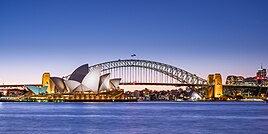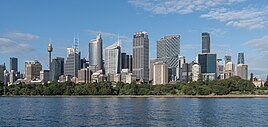
A | B | C | D | E | F | G | H | CH | I | J | K | L | M | N | O | P | Q | R | S | T | U | V | W | X | Y | Z | 0 | 1 | 2 | 3 | 4 | 5 | 6 | 7 | 8 | 9
| Sydney New South Wales | |||||||||
|---|---|---|---|---|---|---|---|---|---|
 Map of the Sydney metropolitan area | |||||||||
| Coordinates | 33°52′04″S 151°12′36″E / 33.86778°S 151.21000°E | ||||||||
| Population | 5,450,496 (2023)[1] (1st) | ||||||||
| • Density | 441/km2 (1,140/sq mi) (2023)[1] | ||||||||
| Established | 26 January 1788 | ||||||||
| Area | 12,367.7 km2 (4,775.2 sq mi)(GCCSA)[2] | ||||||||
| Time zone | AEST (UTC+10) | ||||||||
| • Summer (DST) | AEDT (UTC+11) | ||||||||
| Location | |||||||||
| LGA(s) | Various (33) | ||||||||
| County | Cumberland[3] | ||||||||
| State electorate(s) | Various (49) | ||||||||
| Federal division(s) | Various (24) | ||||||||
| |||||||||
Sydney is the capital city of the state of New South Wales and the most populous city in Australia. Located on Australia's east coast, the metropolis surrounds Sydney Harbour and extends about 80 km (50 mi) from the Pacific Ocean in the east to the Blue Mountains in the west, and about 80 km (50 mi) from the Ku-ring-gai Chase National Park and the Hawkesbury River in the north and north-west, to the Royal National Park and Macarthur in the south and south-west.[5] Greater Sydney consists of 658 suburbs, spread across 33 local government areas. Residents of the city are colloquially known as "Sydneysiders".[6] The estimated population in June 2023 was 5,450,496,[1] which is about 66% of the state's population.[7] The city's nicknames include the "Emerald City" and the "Harbour City".[8]
Aboriginal Australians have inhabited the Greater Sydney region for at least 30,000 years, and their engravings and cultural sites are common. The traditional custodians of the land on which modern Sydney stands are the clans of the Darug, Dharawal and Eora peoples.[9] During his first Pacific voyage in 1770, James Cook charted the eastern coast of Australia, making landfall at Botany Bay. In 1788, the First Fleet of convicts, led by Arthur Phillip, founded Sydney as a British penal colony, the first European settlement in Australia.[10] After World War II, Sydney experienced mass migration and by 2021 over 40 per cent of the population was born overseas. Foreign countries of birth with the greatest representation are mainland China, India, the United Kingdom, Vietnam and the Philippines.[11]
Despite being one of the most expensive cities in the world,[12][13] Sydney frequently ranks in the top ten most liveable cities.[14][15][16] It is classified as an Alpha city by the Globalization and World Cities Research Network, indicating its influence in the region and throughout the world.[17][18] Ranked eleventh in the world for economic opportunity,[19] Sydney has an advanced market economy with strengths in education, finance, manufacturing and tourism.[20][21] The University of Sydney and the University of New South Wales are ranked equal 19th in the world.[22]
Sydney has hosted major international sporting events such as the 2000 Summer Olympics. The city is among the top fifteen most-visited,[23] with millions of tourists coming each year to see the city's landmarks.[24] The city has over 1,000,000 ha (2,500,000 acres) of nature reserves and parks,[25] and its notable natural features include Sydney Harbour and Royal National Park. The Sydney Harbour Bridge and the World Heritage-listed Sydney Opera House are major tourist attractions. Central Station is the hub of Sydney's suburban and light rail networks and longer-distance services, with metro platforms under construction. The main passenger airport serving the city is Kingsford Smith Airport, one of the world's oldest continually operating airports.[26]
Toponymy
In 1788, Captain Arthur Phillip, the first governor of New South Wales, named the cove where the first British settlement was established Sydney Cove after Home Secretary Thomas Townshend, 1st Viscount Sydney.[27] The cove was called Warrane by the Aboriginal inhabitants.[28] Phillip considered naming the settlement Albion, but this name was never officially used.[27] By 1790 Phillip and other officials were regularly calling the township Sydney.[29] Sydney was declared a city in 1842.[30]
The Gadigal (Cadigal) clan, whose territory stretches along the southern shore of Port Jackson from South Head to Darling Harbour, are the traditional owners of the land on which the British settlement was initially established, and call their territory Gadi (Cadi). Aboriginal clan names within the Sydney region were often formed by adding the suffix "-gal" to a word denoting the name for their territory, a specific place in their territory, a food source, or totem. Greater Sydney covers the traditional lands of 28 known Aboriginal clans.[31]
History
First inhabitants of the region

The first people to inhabit the area now known as Sydney were Aboriginal Australians who had migrated from southeast Asia via northern Australia.[32] Flaked pebbles found in Western Sydney's gravel sediments might indicate human occupation from 45,000 to 50,000 years ago,[33] while radiocarbon dating has shown evidence of human activity in the region from around 30,000 years ago.[34] Prior to the arrival of the British, there were 4,000 to 8,000 Aboriginal people in the greater Sydney region.[35][9]
The inhabitants subsisted on fishing, hunting, and gathering plants and shellfish. The diet of the coastal clans was more reliant on seafood whereas hinterland clans ate more forest animals and plants. The clans had distinctive equipment and weapons mostly made of stone, wood, plant materials, bone and shell. They also differed in their body decorations, hairstyles, songs and dances. Aboriginal clans had a rich ceremonial life, part of a belief system centring on ancestral, totemic and supernatural beings. People from different clans and language groups came together to participate in initiation and other ceremonies. These occasions fostered trade, marriages and clan alliances.[36]
The earliest British settlers recorded the word 'Eora' as an Aboriginal term meaning either 'people' or 'from this place'.[37][9] The clans of the Sydney area occupied land with traditional boundaries. There is debate, however, about which group or nation these clans belonged to, and the extent of differences in language and rites. The major groups were the coastal Eora people, the Dharug (Darug) occupying the inland area from Parramatta to the Blue Mountains, and the Dharawal people south of Botany Bay.[9] Darginung and Gundungurra languages were spoken on the fringes of the Sydney area.[38]







